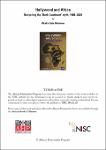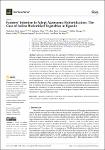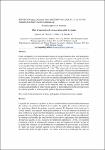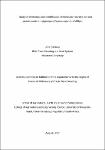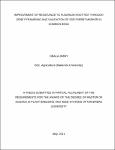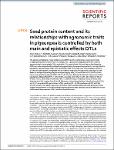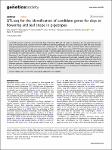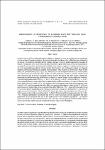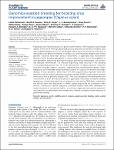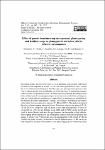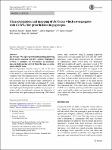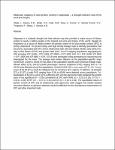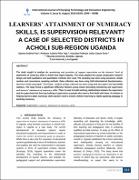Faculty of Education: Recent submissions
Now showing items 1-20 of 27
-
Factors influencing willingness to pay for improved solid waste collection services among households in urban cities in Uganda: empirical evidence from Lira City.
(BMC Public Health, 2024)Waste management in Lira City, Uganda faces significant challenges, particularly in the area of waste collection. Pollution and health risks from uncollected waste are rampant, posing serious threats to human health ... -
Towards More Sustainable Development
(ifa (Institut für Auslandsbeziehungen e. V.), 2024)What is the role of multilateral organisations in delivering the Sustainable Development Agenda and what is the significance of Cultural Relations for this discussion? This report reflects the views expressed at the 2023 ... -
Hollywood and Africa Recycling the ‘Dark Continent’ myth, 1908–2020
(African Humanities Program, 2018)Negative imaging of Africa through the Dark Continent trope continues unabated in Western cultural productions. While colonial historiography has been successfully challenged by various professional historians on the ... -
Beyond Monuments: The politics and poetics of memory in post-war northern Uganda The politics and poetics of memory in post-war northern Uganda
(NISC (Pty) Ltd, 2023)Beyond Monuments: The politics and poetics of memory in post-war northern Uganda explores themes of war and peace, displacement and return, and remembering and forgetting, depicted as experiences of survivors of mass ... -
Economic Feasibility of Iodine Agronomic Biofortification
(sustainability, 2021)Cost–benefit analysis of (iodine) biofortification at farm level is limited in the literature. This study aimed to analyze the economic feasibility of applying iodine-rich fertilizers (agronomic biofortification) to ... -
Farmers’ Intention to Adopt Agronomic Biofortification: The Case of Iodine Biofortified Vegetables in Uganda
(horticulturae, 2023)Agronomic biofortification, the application of fertilizer to increase micronutrient concentrations in staple food crops, has been increasingly promoted as a valuable approach to alleviate micronutrient deficiencies, but ... -
Effect of improved seed system on potato yields in Uganda
(RUFORUM Working Document Series, 2018)Potato seed quality is an important determinant of crop performance, final yield and quality. The quality of seed used by farmers depend on the existing seed system. In Uganda, since the formal sector has limited capacity ... -
Study of inheritance and identification of molecular markers for seed protein content in pigeonpea (Cajanus cajan (L.) Millsp.)
(University of KwaZulu-Natal, Pietermaritzburg, Republic of South Africa, 2017)Pigeonpea is an important source of protein to the vegetarian and poor families around the globe, however, very little is known about the genetic control of seed protein content (SPC) and how it relates with other ... -
Improvement of resistance to Fusarium root rot through gene pyramiding and validation of SSR PVBR87 marker in common bean
(Makerere University, 2011)Fusarium root rot caused by Fusarium solani f. sp. phaseoli is among the most serious diseases of the common bean in Uganda causing total crop loss in susceptible cultivars. Studies have indicated that 2-9 genes located ... -
Seed protein content and its relationships with agronomic traits in pigeonpea is controlled by both main and epistatic efects QTLs
(Scientific Reports, 2020)The genetic architecture of seed protein content (SPC) and its relationships to agronomic traits in pigeonpea is poorly understood. Accordingly, fve F2 populations segregating for SPC and four agronomic traits (seed ... -
QTL-seq for the identification of candidate genes for days to flowering and leaf shape in pigeonpea
(Heredity, 2022)To identify genomic segments associated with days to flowering (DF) and leaf shape in pigeonpea, QTL-seq approach has been used in the present study. Genome-wide SNP profiling of extreme phenotypic bulks was conducted for ... -
Pyramiding Fusarium root rot resistance genes and validation of SSR PVBR87 in common bean
(RUFORUM, 2010)This study determined effectiveness of pyramided Fusarium root rot (FRR) resistance genes and validated association of SSR PVBR87 marker with FRR resistance in common bean. A double cross (DC) involving four resistance ... -
IMPROVEMENT OF RESISTANCE TO FUSARIUM ROOT ROT THROUGH GENE PYRAMIDING IN COMMON BEAN
(African Crop Science Journal, 2012)Fusarium root rot (FRR), caused by Fusarium solani f.sp. phaseoli, is one of the most serious root rot diseases of common bean (Phaseolus vulgaris L.) throughout the world. Yield losses of up to 84% have been attributed ... -
Genomics-assisted breeding for boosting crop improvement in pigeonpea (Cajanus cajan)
(Frontiers in plant science, 2015)Pigeonpea is an important pulse crop grown predominantly in the tropical and sub-tropical regions of the world. Although pigeonpea growing area has considerably increased, yield has remained stagnant for the last six ... -
Genetic variation and relationships of total seed protein content with some agronomic traits in pigeonpea (Cajanus cajan (L.) Millsp.)
(Australian Journal of Crop Science, 2018)Seed protein content (SPC) is an important grain quality trait, which impacts the nutritional importance of pigeonpea seed in the diet of over a billion people globally. The present study was carried out to determine ... -
Effect of potato-bean intercrop arrangement, plant spacing and fertiliser usage on plant growth and tuber yield in different environments
(Makerere University Journal of Agricultural and Environmental Sciences, 2022)In Uganda, potato (Solanum tuberosum. L) is an important cash and food crop but its productivity has stagnated at around 3.5 t ha-1, far below potential (20 t ha-1), mainly due to soil exhaustion resulting from land ... -
Development of sequence-based markers for seed protein content in pigeonpea
(Molecular Genetics and Genomics, 2019)Pigeonpea is an important source of dietary protein to over a billion people globally, but genetic enhancement of seed protein content (SPC) in the crop has received limited attention for a long time. Use of genomics-assisted ... -
Characterization and mapping of Dt1 locus which co‑segregates with CcTFL1 for growth habit in pigeonpea
(Theor Appl Genet, 2017)Pigeonpea (Cajanus cajan) is one of the most important legume crops grown in arid and semi-arid regions of the world. It is characterized with few unique features compared with other legume species, such as Lotus, ... -
Molecular mapping of seed protein content in pigeonpea – a drought tolerant crop of the semi-arid tropics
(: InterDrought, 2017)Pigeonpea is a uniquely drought and heat tolerant crop that provides a major source of dietary protein to nearly a billion people in the tropical and semi-arid tropics of the world. Despite its importance as a source of ... -
Learners’ Attainment of Numeracy Skills, is Supervision Relevant? a case of Selected Districts in Acholi Sub-Region Uganda
(International Journal of Emerging Technology and Innovative Engineering, 2019)The study sought to analyse the monitoring and provision of support supervision on the learners’ level of attainment of numeracy skills in Acholi Sub-region Uganda. The study adopted the casual comparative research design ...



